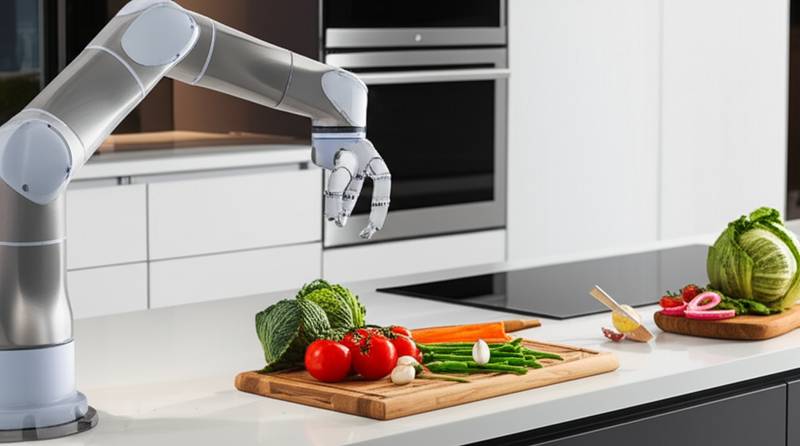Robotic Arms Prepare Dinner While You Work
Smart homes advance beyond basic automation toward comprehensive assistance, particularly in the kitchen. Envision arriving home after a demanding day to discover a perfectly prepared meal awaiting you. Robotic kitchen systems make this scenario achievable through robotics, sensors, and advanced programming that manage meal preparation.
Prototypes and initial consumer models demonstrate the feasibility of these technologies. These robotic arms extend beyond mere assistance; they redefine approaches to household tasks, time allocation, and culinary innovation.
Emergence of Automated Cooking Systems
Development of robot-assisted cooking spans years, yet recent robotic arm advancements realize this vision. Systems typically include two dexterous arms positioned over a smart cooktop, fitted with cameras, sensors, and exact motion controls. These components enable replication of human actions, such as slicing produce or mixing sauces.
Various manufacturers and startups refine these designs. Certain models employ machine learning to capture a professional chef's techniques, converting the data into executable sequences. Consequently, the devices execute intricate recipes with precision comparable to skilled cooks. For individuals who prioritize homemade meals amid tight schedules, such technology offers significant advantages.
Impact on Daily Routines
Time constitutes a precious asset in households. Research indicates that meal preparation often consumes over an hour daily for many. Automation via robotic systems restores this duration for family interactions, leisure activities, or rest.
Health improvements accompany this shift. In contrast to convenience foods or deliveries, these kitchens utilize fresh components to create balanced dishes. Users dictate recipes, servings, and selections, facilitating adherence to nutritional plans without routine preparation demands. Integration with wellness applications allows meal recommendations aligned with personal objectives.
Components of a Robotic Kitchen Setup
A robotic kitchen encompasses more than mechanical arms; it forms a cohesive network with a smart cooktop, specialized tools, and chilled storage for ingredients. The robot accesses items, portions them precisely, and coordinates actions to assemble meals. Sensors track heat levels, consistencies, and durations to avoid mishaps like burning.
Advanced versions link to online recipe collections, enabling selection via mobile devices or voice commands. Upon choice, the system arranges materials, warms the surface, and initiates cooking. Completion triggers utensil and area sanitization, ensuring a tidy environment. This design emphasizes reliability, uniformity, and hygiene.
Pioneering Market Solutions
Multiple enterprises lead in this domain, adopting distinct strategies. One prominent developer offers a complete robotic kitchen for seamless installation in contemporary residences. It documents chef demonstrations and duplicates them via accurate arm movements. Alternatively, another provider supplies adaptable robotic units that integrate into current setups, avoiding extensive modifications.
Commercial sectors, including restaurants and hotels, test analogous technologies for business applications. Such arms deliver uniform results during busy periods, lowering staffing expenses and enhancing operations. Refinements from professional use hasten adaptations for residential markets.
Addressing Key Challenges
Excitement surrounds these systems, yet hurdles persist. Expense poses the primary barrier, given the sophisticated parts and craftsmanship involved. Initial units target premium consumers, but analysts forecast price reductions with increased manufacturing and interest. Setup demands expert intervention for alignment and testing.
Trust issues arise regarding machine operation near hazards like blades and heat sources. Developers counter this with safeguards such as heat detectors, halt mechanisms, and barriers. Proven dependability fosters greater user confidence over time.
Integration of AI and Analytics
Robotic arms execute manual duties, while artificial intelligence oversees strategy. The platform evolves through recipe executions and user inputs, optimizing durations, replacements, or flavor adjustments. Accumulated data from preparations and responses enhances customization.
Certain interfaces sync with delivery platforms. Inventory monitoring prompts restocking alerts, streamlining the cycle of selection, procurement, and execution. This automation alleviates cognitive burdens tied to daily nutrition.
Shifting Lifestyles with Kitchen Automation
Robotic cooking transcends productivity; it signals a move to intuitive living environments that respond to needs. Systems initiate proactively, commencing meals based on schedules or geolocation from devices. Residences function as anticipatory aides, addressing requirements ahead of awareness.
Families gain enhanced togetherness with reduced pressures. Professionals enjoy nutritious options without productivity trade-offs. Culinary enthusiasts benefit as machines manage mundane steps, freeing capacity for innovation.
Envisioning Tomorrow's Kitchen Landscape
Affordability and miniaturization of robotic arms will drive broad integration into intelligent homes. Kitchens will develop as interconnected hubs where devices exchange information. Refrigerators may propose dishes from available stock, with robotic units managing execution. Central controls via voice systems will orchestrate timing and maintenance.
This evolution implies delegation of routine chores to unobtrusive machines. Homes transform into realms of liberty, ease, and tailoring. Meal creation shifts from duty to elective enjoyment.
Steps to Adopt Robotic Cooking Technology
Interest in this field warrants initial exploration of compatible devices. Consider smart ovens or accurate sous-vide tools that pave the way for robotic enhancements. Monitor developers of attachable arm systems for existing kitchen upgrades.
These innovations elevate home efficiency and well-being. They deliver a straightforward yet impactful benefit: residences that manage meals, enabling fuller engagement in life's priorities.
